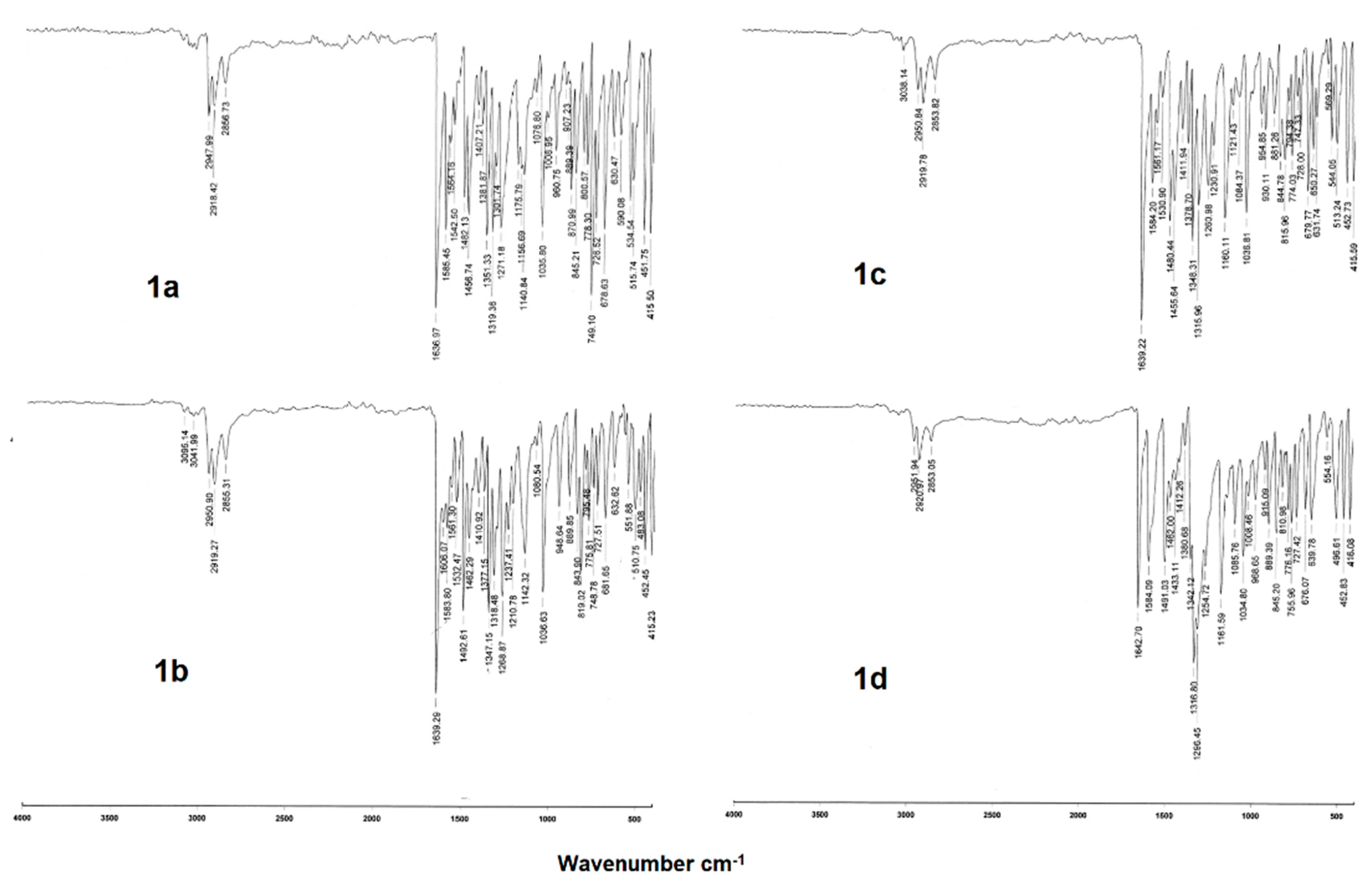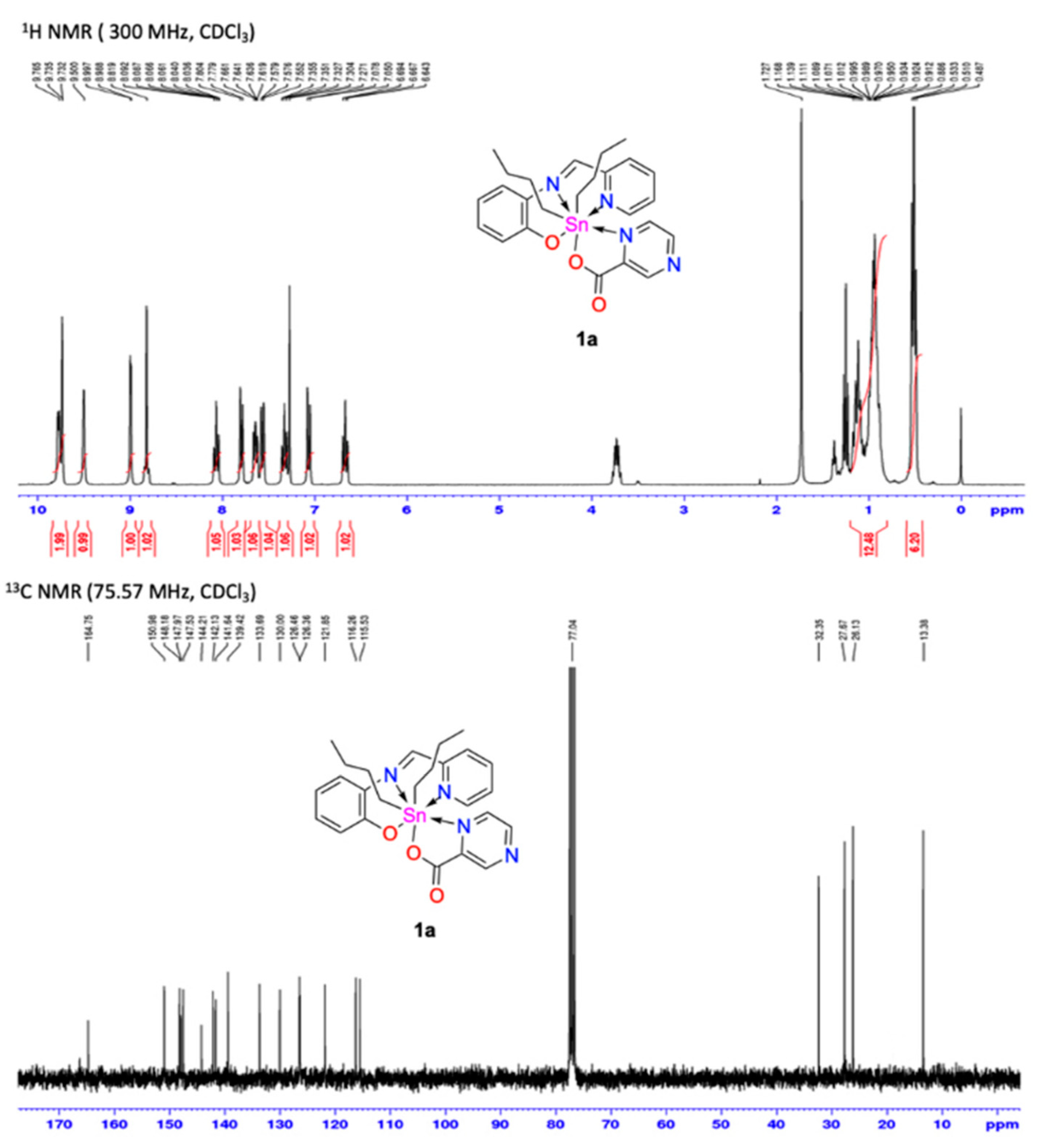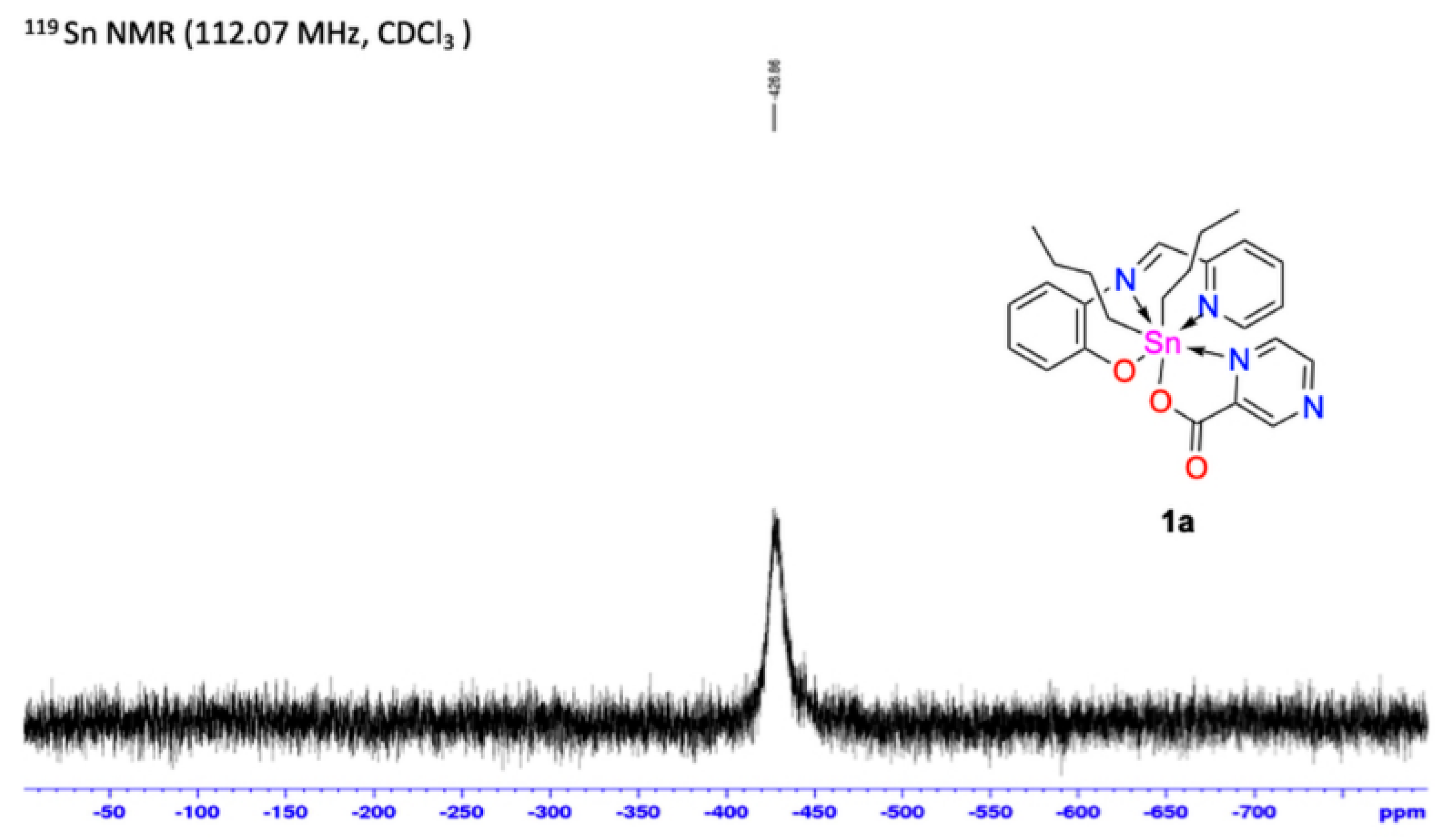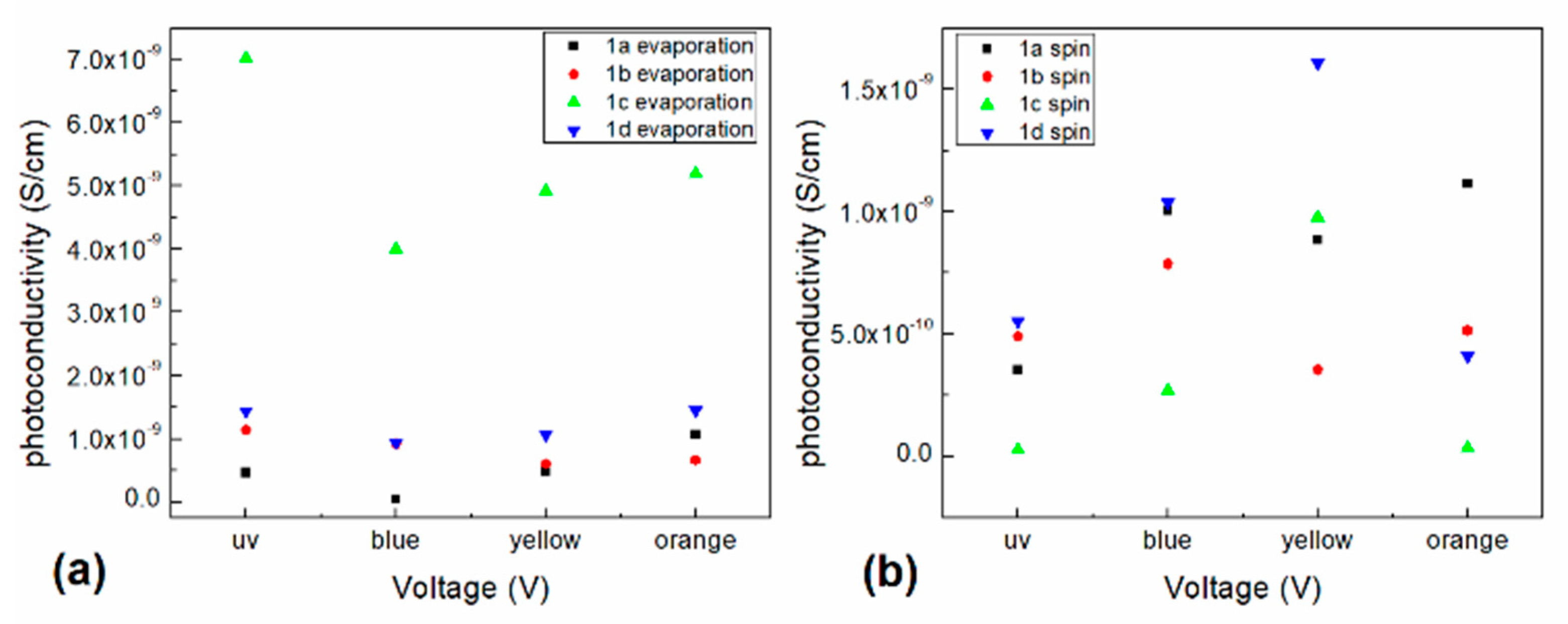Design of Promising Heptacoordinated Organotin (IV) Complexes-PEDOT: PSS-Based Composite for New-Generation Optoelectronic Devices Applications
Abstract
1. Introduction
2. Materials and Methods
2.1. General Procedure for Synthesis of Heptacoordinated Organotin (IV) Complexes 1a–1d
2.1.1. 5,5-Di-n-butyl-1,4-diaza-6-oxatetracyclo [7.12.0.03,803,4]-5-spirostanna-20,23-diaza-17-oxabyciclo-19,20,21-triene [0.0.019,20] heptadeca-3,7,9,11,13,15-hexaene (1a)
2.1.2. 5,5-Di-n-butyl-10-methyl-1,4-diaza-6-oxatetracyclo [7.12.0.03,803,4]-5-spirostanna-20,23-diaza-17-oxabyciclo-19,20,21-triene [0.0.019,20] heptadeca-3,7,9,11,13,15-hexaene (1b)
2.1.3. 5,5-Di-n-butyl-10-chloro-1,4-diaza-6-oxatetracyclo [7.12.0.03,803,4]-5-spirostanna-20,23-diaza-17-oxabyciclo-19,20,21-triene [0.0.019,20] heptadeca-3,7,9,11,13,15-hexaene (1c)
2.1.4. 5,5-Di-n-butyl-10-nitro-1,4-diaza-6-oxatetracyclo [7.12.0.03,803,4]-5-spirostanna-20,23-diaza-17-oxabyciclo-19,20,21-triene [0.0.019,20] heptadeca-3,7,9,11,13,15-hexaene (1d)
2.2. Films and Devices Fabrication
3. Results and Discussion
3.1. Synthesis and Characterization of Heptacoordinated Organotin (IV) Complexes Complexes 1a–d
3.2. Manufacture and Characterization of Films and Optoelectronic Devices
4. Conclusions
Supplementary Materials
Author Contributions
Funding
Institutional Review Board Statement
Informed Consent Statement
Data Availability Statement
Acknowledgments
Conflicts of Interest
References
- Sánchez-Vergara, M.E.; Hamui, L.; González Habib, S. New Approaches in Flexible Organic Field-Effect Transistors (FETs) Using InCIPc. Materials 2019, 12, 1712. [Google Scholar] [CrossRef]
- Chou, T.R.; Chen, S.H.; Chiang, Y.T.; Lin, Y.T.; Chao, C.Y. Approaches for fabricating high efficiency organic light emitting diodes. Mater. Chem. 2015, 3, 3760–3766. [Google Scholar]
- Hains, A.W.; Liang, Z.; Woodhouse, M.A.; Gregg, B.A. Molecular Semiconductors in Organic Photovoltaic Cells. Chem. Rev. 2010, 110, 6689–6735. [Google Scholar] [CrossRef]
- Heeger, A.J. Semiconducting polymers: The third generation. Chem. Soc. Rev. 2010, 39, 2354–2371. [Google Scholar] [CrossRef]
- Tomozawa, H.; Braun, D.; Phillips, S.; Heeger, A.J.; Kroemer, H. Metal-polymer schottky barriers on cast films of soluble poly(3-alkylthiophenes). Synth. Met. 1987, 22, 63–69. [Google Scholar] [CrossRef]
- Ouyang, J.; Chu, C.W.; Chen, F.C.; Xu, Q.; Yang, Y. High-Conductivity Poly(3,4-ethylenedioxythiophene):Poly(styrene sulfonate) Film and Its Application in Polymer Optoelectronic Devices. Adv. Funct. Mater. 2005, 15, 203–208. [Google Scholar] [CrossRef]
- Friend, R.H.; Gymer, R.W.; Holmes, A.B.; Burroughes, J.H.; Marks, R.N.; Taliani, C.; Bradley, D.D.C.; Dos Santos, D.A.; Bredas, J.L.; Logdlund, M.; et al. Electroluminescence in conjugated polymers. Nature 1999, 397, 121–128. [Google Scholar] [CrossRef]
- Chipman, A.A. Single wall carbon nanotubes based transparent conducting films for flexible electronic applications. Commod. No More. Nat. 2007, 449, 131. [Google Scholar]
- Zhang, F.; Johansson, M.; Andersson, M.R.; Hummelen, J.C.; Inganäs, O. Polymer photovoltaic cells with conducting polymer anodes. Adv. Mater. 2002, 14, 662–665. [Google Scholar] [CrossRef]
- Mei, X.G.; Ouyang, J.Y. Ultrasonification-assisted ultrafast reduction of graphene oxide by zinc powder at room temperature. Carbon 2011, 49, 5389–5397. [Google Scholar] [CrossRef]
- Tung, V.C.; Chen, L.M.; Allen, M.J.; Wassei, J.K.; Nelson, K.; Kaner, R.B.; Yang, Y. Low-Temperature Solution Processing of Graphene-Carbon Nanotube Hybrid Materials for High-Performance Transparent Conductors. Nano. Lett. 2009, 9, 1949–1955. [Google Scholar] [CrossRef]
- Yoo, J.E.; Lee, K.S.; Garcia, A.; Tarver, J.; Gomez, E.D.; Baldwin, K.; Sun, Y.M.; Meng, H.; Nguyen, T.Q.; Loo, Y.L. Oxidatively stable polyaniline:polyacid electrodes for electrochemical energy storage. Proc. Natl. Acad. Sci. USA 2010, 107, 5712–5717. [Google Scholar] [CrossRef] [PubMed]
- Xia, Y.J.; Sun, K.; Ouyang, J.Y. Highly conductive poly(3,4-ethylenedioxythiophene): Poly(styrene sulfonate) films treated with an amphiphilic fluoro compound as the transparent electrode of polymer solar cells. Energy Environ. Sci. 2012, 5, 5325–5332. [Google Scholar] [CrossRef]
- Na, S.I.; Kim, S.S.; Jo, J.; Kim, D.Y. Efficient and Flexible ITO-Free Organic Solar Cells Using Highly Conductive Polymer Anodes. Adv. Mater. 2008, 20, 4061–4067. [Google Scholar] [CrossRef]
- Yeon, C.; Kim, G.; Lim, J.W.; Yun, S.J. Highly conductive PEDOT:PSS treated by sodium dodecyl sulfate for stretchable fabric heaters. RSC Adv. 2017, 7, 5888–5897. [Google Scholar] [CrossRef]
- Wang, Y. Research progress on a novel conductive polymer–poly(3,4-ethylenedioxythiophene) (PEDOT). J. Phys. Conf. Ser. 2009, 152, 012023. [Google Scholar] [CrossRef]
- Groenendaal, L.B.; Jonas, F.; Freitag, D.; Pielartzik, H.; Reynolds, J.R. Poly(3,4-ethylenedioxythiophene) and Its Derivatives: Past, Present, and Future. Adv. Mater. 2000, 12, 481–494. [Google Scholar] [CrossRef]
- Cao, Y.; Yu, G.; Zhang, C.; Menon, R.; Heeger, A.J. Improved quantum efficiency for electroluminescence in semiconducting polymers. Synth. Met. 1997, 87, 171–174. [Google Scholar] [CrossRef]
- Kirchmeyer, S.; Reuter, K.J. Scientific importance, properties and growing applications of poly(3,4-ethylenedioxythiophene). Mater. Chem. 2005, 15, 2077–2088. [Google Scholar] [CrossRef]
- Olivares, A.; Cosme, I.; Sánchez-Vergara, M.E.; Carrillo, J.C.; Martinez, H.E.; Itzmoyotl, A. Nanostructural Modification of PEDOT:PSS for High Charge Carrier Collection in Hybrid Frontal Interface of Solar Cells. Polymers 2019, 11, 1034. [Google Scholar] [CrossRef] [PubMed]
- Guselnikova, O.A.; Postnikov, P.S.; Fitl, P.; Tomecek, D.; Sajdl, P.; Elashnikov, R.; Kolska, Z.; Chehimi, M.M.; Švorcík, V.; Lyutakov, O. Flexible Conductive Polymer Film Grafted with Azo-Moieties and Patterned by Light Illumination with Anisotropic Conductivity. J. Polym. Sci. Part. B Polym. Phys. 2017, 55, 378–387. [Google Scholar] [CrossRef]
- Xia, Y.; Ouyang, J. PEDOT:PSS films with significantly enhanced conductivities induced by preferential solvation with cosolvents and their application in polymer photovoltaic cells. J. Mater. Chem. 2011, 21, 4927–4936. [Google Scholar] [CrossRef]
- Song, C.; Zhang, Z.; Hu, Z.; Luo, Y.; Wang, L.; Wang, J.; Cao, Y. Modifying the organic/metal interface via solvent vapor annealing to enhance the performance of blue OLEDs. Org. Electron. 2017, 43, 9–14. [Google Scholar] [CrossRef]
- Hilal, M.; Han, J.I. Improving the Conductivity of PEDOT:PSS to Nearly 1 Million S/m with Graphene on an ITO-glass Substrate. Synth. Met. 2018, 245, 276–285. [Google Scholar] [CrossRef]
- Sánchez Vergara, M.E.; Motomochi-Lozano, J.D.; Cosme, I.; Hamui, L.; Olivares, A.J.; Galván-Hidalgo, J.M.; Gómez, E. Gaceta digital del Instituto de Química UNAM. Semicond. Sci. Technol. 2020, 35, 12. [Google Scholar]
- Fan, B.; Mei, X.G.; Ouyang, J.Y. Significant Conductivity Enhancement of Conductive Poly(3,4-ethylenedioxythiophene):Poly(styrenesulfonate) Films by Adding Anionic Surfactants into Polymer Solution. Macromolecules 2008, 41, 5971–5973. [Google Scholar] [CrossRef]
- Devi, T.; Lee, Y.M.; Nam, W.; Fukuzumi, S. A Mononuclear Non-Heme Manganese(III)–Aqua Complex in Oxygen Atom Transfer Reactions via Electron Transfer. Coord. Chem. Rev. 2020, 143, 1521–1528. [Google Scholar]
- Hardy, J.G. Metallosupramolecular grid complexes: Towards nanostructured materials with high-tech applications. Chem. Soc. Rev. 2013, 42, 7881–7899. [Google Scholar] [CrossRef]
- Kilinc, D.; Şahin, Ö.; Horoz, S. Use of low-cost Zn (II) complex efficiently in a dye-sensitized solar cell device. J. Mater. Sci. Mater. Electron. 2019, 30, 11464–11467. [Google Scholar] [CrossRef]
- Hazra, S.; Mohanta, S. Metal–tin derivatives of compartmental Schiff Bases: Synthesis, structure and application. Coord. Chem. Rev. 2019, 395, 1–24. [Google Scholar] [CrossRef]
- Kirubel, T.T.; Tilahun, W.T. Schiff Bases and their Metal Complexes as Potential Anticancer Candidates: A Review of Recent Works. Anti Cancer Agents Med. Chem. 2019, 19, 1786–1795. [Google Scholar]
- Mondal, I.; Chattopadhyay, S. Development of multi-metallic complexes using metal-salen complexes as building blocks. J. Coord. Chem. 2019, 72, 3183–3209. [Google Scholar] [CrossRef]
- Abdel Aziz, A.A.; Seda, S.H. Synthesis, structural features and biochemical activity assessment of N,N′-bis-(2-mercaptophenylimine)-2,5-thiophenedicarboxaldehyde Schiff base and its Co(II), Ni(II), Cu(II) and Zn(II) complexes. Appl. Organomet. Chem. 2017, 31, 3879. [Google Scholar] [CrossRef]
- Liu, X.; Hamon, J.R. Recent developments in penta-, hexa- and heptadentate Schiff base ligands and their metal complexes. Coord. Chem. Rev. 2019, 389, 94–118. [Google Scholar] [CrossRef]
- Nath, M.; Saini, P.K. Chemistry and applications of organotin(iv) complexes of Schiff bases. Dalton Trans. 2011, 40, 7077–7121. [Google Scholar] [CrossRef] [PubMed]
- Devi, J.; Pachwania, S. Syntheses, Molecular Structures, Electrochemical Behavior, Theoretical Study, and Antitumor Activities of Organotin(IV) Complexes Containing 1-(4-Chlorophenyl)-1-cyclopentanecarboxylato Ligands. Inorg. Chem. 2018, 91, 44–62. [Google Scholar]
- Xiao, X.; Li, C.; Lai, H. Cocrystallization of Paracetamol-Picric acid: Hirshfeld surface analysis, supramolecular architecture and third-order nonlinear optical properties. J. Mol. Struct. 2019, 1190, 116–124. [Google Scholar] [CrossRef]
- Xiao, X.; Liang, J.; Xie, J.; Liu, X.; Zhu, D.; Dong, Y. Using density functional theory to increase the accuracy of experimental crystal structures: The case of potassium peroxocarbonate. J. Mol. Struct. 2017, 1146, 233–241. [Google Scholar] [CrossRef]
- Vasquez-Ríos, M.G.; Rojas-León, I.; Montes-Tolentino, P.; Hernández-Ahuactzi, I.F.; Höpfl, H. Pyridinedicarboxylic Acids as Versatile Building Blocks for Coordination-Driven Self-Assembly: Solvent-Induced Macrocycle and Coordination Polymer Formation upon Combination of 2,5-Pyridinedicarboxylate with Diorganotin Moieties. Cryst. Growth Des. 2018, 18, 7132–7149. [Google Scholar] [CrossRef]
- Rojas-León, I.; Alnasr, H.; Jurkschat, K.; Vasquez-Ríos, M.G.; Hernández-Ahuactzi, I.F.; Höpfl, H. Molecular Tectonics with Di- and Trinuclear Organotin Compounds. Chem. A Eur. J. 2018, 24, 4547–4551. [Google Scholar] [CrossRef] [PubMed]
- Sirajuddin, M.; Ali, S.; McKee, V.; Wadood, A.; Ghufran, M. New 1D diorganotin(iv) dithiolate coordination polymers: Crystallographic, computational, Hirshfeld surface and thermal analyses. J. Mol. Struct. 2019, 1181, 93–108. [Google Scholar] [CrossRef]
- Guan, R.; Zhou, Z.; Zhang, M. Organotin(IV) carboxylate complexes containing polyether oxygen chains with two-photon absorption in the near infrared region and their anticancer activity. Dyes Pigment. 2018, 158, 428–437. [Google Scholar] [CrossRef]
- Devendra, R.; Edmonds, N.R.; Söhnel, T. Insight into the mechanism of the catalysis of urethane formation by organotin(IV) dicarboxylate. React. Kinet. Mech. Catal. 2018, 124, 487–502. [Google Scholar] [CrossRef]
- Arkış, E.; Balköse, D. Vinyl-functionalized polysiloxane as radical scavenger during the degradation of poly(vinyl chloride). Polym. Degrad. Stabil. 2005, 88, 46–51. [Google Scholar] [CrossRef]
- Cantón-Díaz, A.M.; Muñoz-Flores, B.M.; Moggio, I. One-pot microwave-assisted synthesis of organotin Schiff bases: An optical and electrochemical study towards their effects in organic solar cells. New J. Chem. 2018, 42, 14586–14596. [Google Scholar] [CrossRef]
- García-López, M.C.; Muñoz-Flores, B.M.; Chan-Navarro, R. Microwave-assisted synthesis, third-order nonlinear optical properties, voltammetry cyclic and theoretical calculations of organotin compounds bearing push–pull Schiff bases. J. Organomet. Chem. 2016, 806, 68–76. [Google Scholar] [CrossRef]
- Kayunkid, N.; Rangkasikorn, A.; Saributr, C.; Nukeaw, J. Growth and characterizations of tin doped zinc-phthalocyanine prepared by thermal co-evaporation in high vacuum as a nanomaterial. Jpn. J. Appl. Phys. 2016, 55, 02BB12. [Google Scholar] [CrossRef]
- Saleh, A.M.; Abu-Hilal, A.O.; Gould, R.D. Investigation of electrical properties (ac and dc) of organic zinc phthalocyanine, ZnPc, semiconductor thin films. Curr. Appl. Phys. 2003, 55, 345–350. [Google Scholar] [CrossRef]
- Galván-Hidalgo, J.M.; Ramírez-Apan, T.; Nieto-Camacho, A.; Hernández-Ortega, S.; Gómez, E. Schiff base Sn(IV) complexes as cytotoxic agents: Synthesis, structure, isosteric and bioisosteric replacement. J. Organomet. Chem. 2017, 848, 332–343. [Google Scholar] [CrossRef]
- Galván-Hidalgo, J.M.; Chans, G.M.; Ramírez-Apan, T.; Nieto-Camacho, A.; Hernández-Ortega, S.; Gómez, E. Tin(IV) Schiff base complexes derived from pyridoxal: Synthesis, spectroscopic properties and cytotoxicity. Appl. Organomet. Chem. 2017, 31, e3704. [Google Scholar] [CrossRef]
- Singh, H.L.; Singh, J.B.; Sharma, K.P. Synthesis, spectroscopic characterization, biological screening, and theoretical studies of organotin(IV) complexes of semicarbazone and thiosemicarbazones derived from (2-hydroxyphenyl)(pyrrolidin-1-yl)methanone. Res. Chem. Intermed. 2012, 38, 53–65. [Google Scholar] [CrossRef]
- Ramírez-Jiménez, A.; Luna-García, R.; Cortés-Lozada, A. Dinuclear heptacoordinate dibutyltin (IV) complexes derived from Schiff bases and dicarboxylates: Synthesis, cytotoxicity, and antioxidant activity. J. Organomet. Chem. 2013, 738, 10–19. [Google Scholar] [CrossRef]
- Rocha, C.S.; Morais, B.P.; Rodrigues, B.L. Spectroscopic and X-ray structural characterization of new polymeric organotin(IV) carboxylates and their in vitro antifungal activities: Part II. Appl. Organomet. Chem. 2017, 31, e3645. [Google Scholar] [CrossRef]
- Chans, G.M.; Nieto-Camacho, A.; Ramírez-Apan, T.; Hernández-Ortega, S.; Álvarez-Toledano, C.; Gómez, E. Synthetic, spectroscopic, crystallographic, and biological studies of seven-coordinated Diorganotin(IV) complexes derived from Schiff bases and pyridinic carboxylic acids. Aust. J. Chem. 2016, 69, 279–290. [Google Scholar] [CrossRef]
- Rigana Begam, M.; Madhusudhana Rao, N.; Kaleemulla, S.; Sai Krishna, N.; Kuppan, M.; Krishnaiah, G.; Subrahmanya, J. Room temperature ferromagnetism in Cd1− xCrxTe diluted magnetic semiconductor crystals. Mater. Sci. Semicond Process. 2014, 18, 146–151. [Google Scholar] [CrossRef]
- Günes, S.; Neugebauer, H.; Sariciftci, N.S. Conjugated Polymer-Based Organic Solar Cells. Chem. Rev. 2007, 107, 1324–1338. [Google Scholar] [CrossRef] [PubMed]
- Hoppe, H.; Sariciftci, N.S. Organic solar cells: An overview. Mater. Chem. 2004, 19, 1924. [Google Scholar] [CrossRef]
- Niu, H.J.; Huang, Y.D.; Bai, X.D.; Xin, L. Microstructure and martensitic transformation of Ti49Ni51− xHfx high temperature shape memory alloys. Mater. Lett. 2004, 58, 2979–2983. [Google Scholar] [CrossRef]









| Sample | Eg (eV) Pellet | Eg (eV) Evaporated Film | Eg (eV) Complex-PEDOT:PSS Film |
|---|---|---|---|
| 1a | 1.98 | 1.37 | 3.17 |
| 1b | 1.89 | 1.40 | 3.27 |
| 1c | 1.88 | 1.23 | 3.48 |
| 1d | 1.95 | 1.31 | 3.10 |
| Sample | Slope Region | Slope Region | Mobility | Vth | Is | n | Photocurrent |
|---|---|---|---|---|---|---|---|
| 1 | 2 | cm2/V s | V | A | A | ||
| Ohmic | SCLC | @ 0 V | |||||
| Dark 1a Evaporation | 0.812 | 2.015 | 6.84 × 10−1 | 3.59 × 10−4 | 1.29 × 10−5 | 1.06 | 1.29 × 10−7 |
| Dark 1b Evaporation | 0.809 | 2.027 | 3.89 × 10−2 | 3.61 × 10−4 | 1.29 × 10−5 | 1.12 | 1.52 × 10−7 |
| Dark 1c Evaporation | 0.918 | 2.079 | 5.27 × 10−1 | 4.32 × 10−4 | 1.09 × 10−5 | 1.53 | 2.98 × 10−7 |
| Dark 1d Evaporation | 0.804 | 2.020 | 8.63 × 10−1 | 3.59 × 10−4 | 1.30 × 10−5 | 1.11 | 1.68 × 10−7 |
| Dark 1a Spincoating | 0.910 | 2.321 | 4.38 × 10−2 | 4.79 × 10−4 | 1.18 × 10−5 | 1.32 | 1.97 × 10−7 |
| Dark 1b Spincoating | 0.955 | 2.274 | 4.34 × 10−2 | 4.76 × 10−4 | 1.06 × 10−5 | 0.68 | 2.99 × 10−7 |
| Dark 1c Spincoating | 0.809 | 1.999 | 4.08 × 10−2 | 3.52 × 10−4 | 1.30 × 10−5 | 1.11 | 2.81 × 10−7 |
| Dark 1d Spincoating | 0.900 | 2.307 | 4.38 × 10−2 | 4.78 × 10−4 | 1.23 × 10−5 | 1.23 | 9.83 × 10−8 |
Publisher’s Note: MDPI stays neutral with regard to jurisdictional claims in published maps and institutional affiliations. |
© 2021 by the authors. Licensee MDPI, Basel, Switzerland. This article is an open access article distributed under the terms and conditions of the Creative Commons Attribution (CC BY) license (http://creativecommons.org/licenses/by/4.0/).
Share and Cite
Sánchez-Vergara, M.E.; Hamui, L.; Gómez, E.; Chans, G.M.; Galván-Hidalgo, J.M. Design of Promising Heptacoordinated Organotin (IV) Complexes-PEDOT: PSS-Based Composite for New-Generation Optoelectronic Devices Applications. Polymers 2021, 13, 1023. https://doi.org/10.3390/polym13071023
Sánchez-Vergara ME, Hamui L, Gómez E, Chans GM, Galván-Hidalgo JM. Design of Promising Heptacoordinated Organotin (IV) Complexes-PEDOT: PSS-Based Composite for New-Generation Optoelectronic Devices Applications. Polymers. 2021; 13(7):1023. https://doi.org/10.3390/polym13071023
Chicago/Turabian StyleSánchez-Vergara, María Elena, Leon Hamui, Elizabeth Gómez, Guillermo M. Chans, and José Miguel Galván-Hidalgo. 2021. "Design of Promising Heptacoordinated Organotin (IV) Complexes-PEDOT: PSS-Based Composite for New-Generation Optoelectronic Devices Applications" Polymers 13, no. 7: 1023. https://doi.org/10.3390/polym13071023
APA StyleSánchez-Vergara, M. E., Hamui, L., Gómez, E., Chans, G. M., & Galván-Hidalgo, J. M. (2021). Design of Promising Heptacoordinated Organotin (IV) Complexes-PEDOT: PSS-Based Composite for New-Generation Optoelectronic Devices Applications. Polymers, 13(7), 1023. https://doi.org/10.3390/polym13071023







